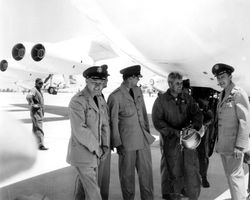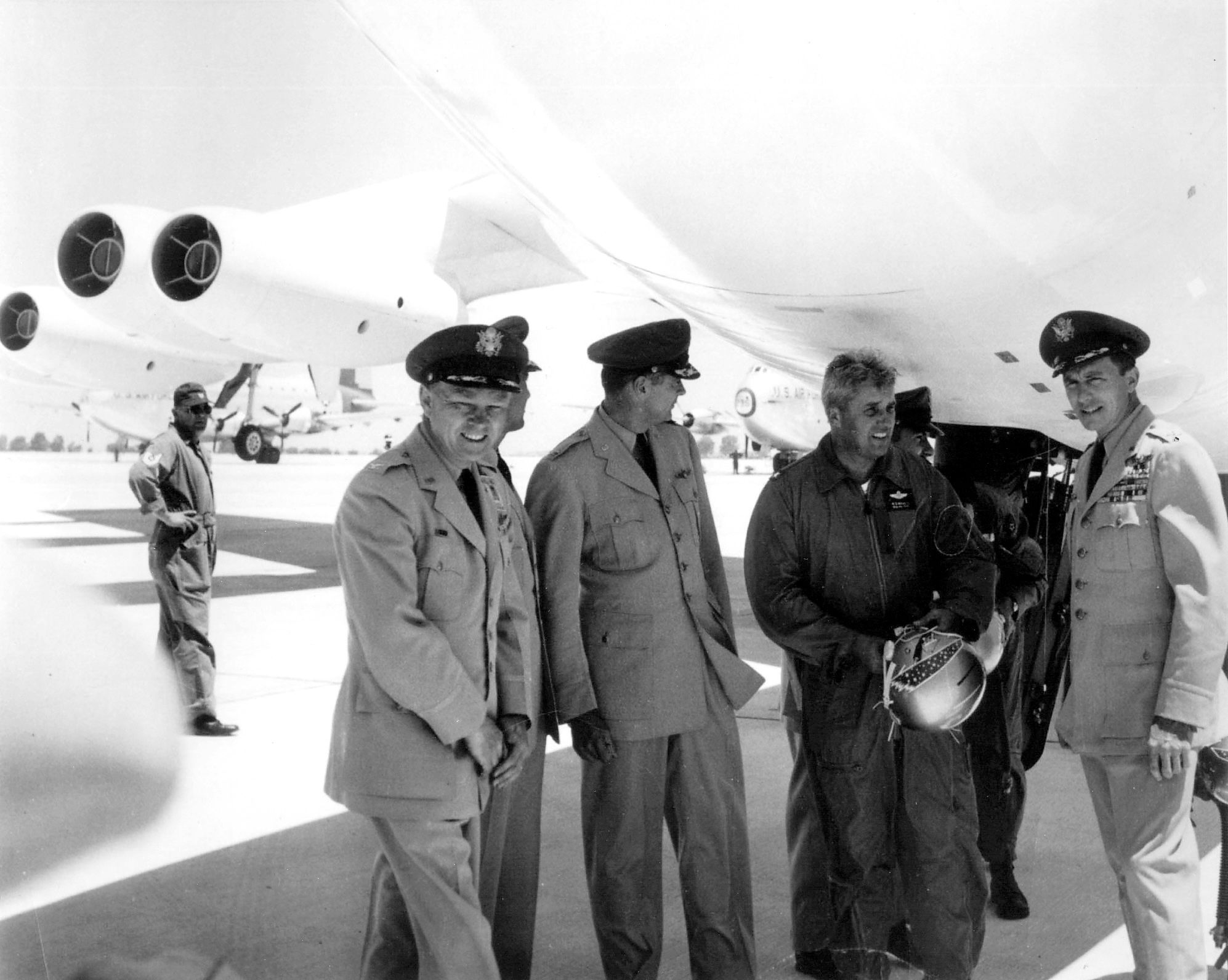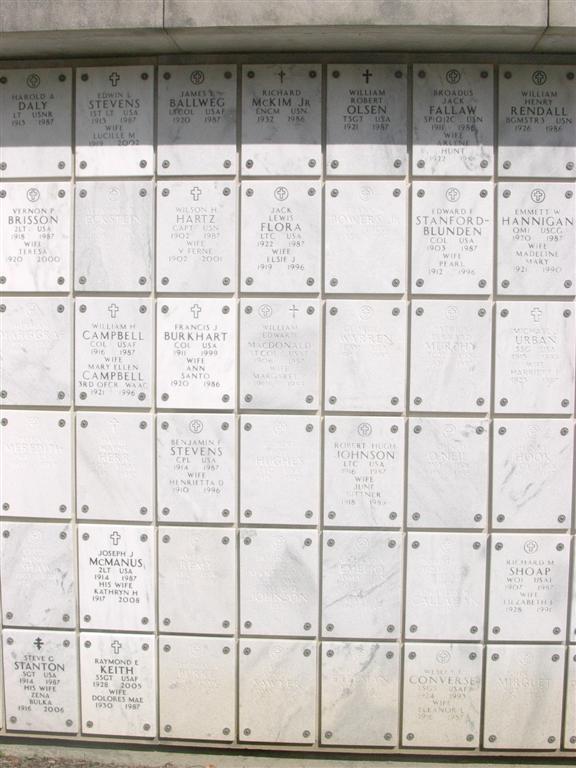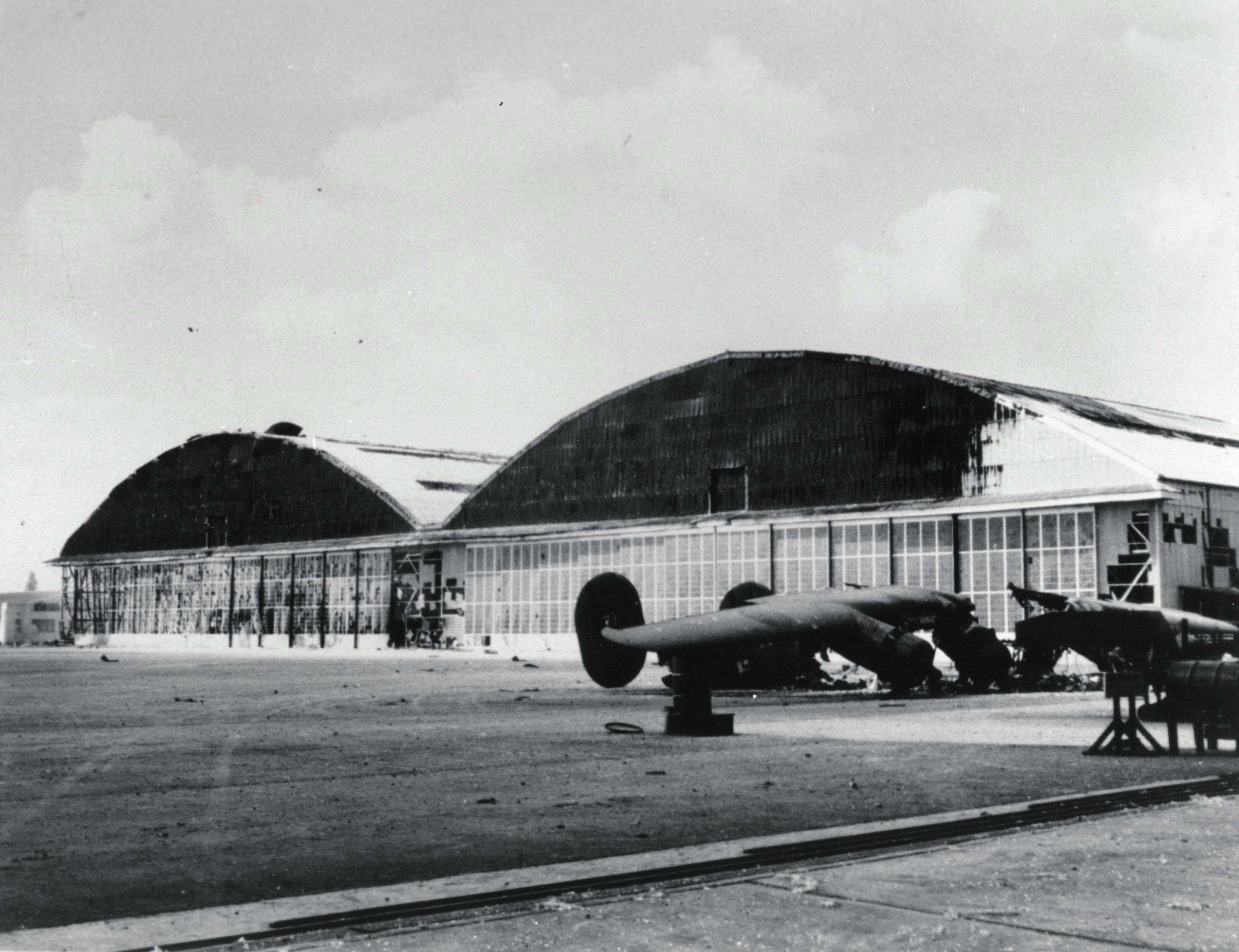father: Lloyd Corr "Beppo" CAMPBELL ("Sr.")
and mother: Olive Madeline (WALLENIUS) CAMPBELL
Born in 1916, Bill was a teenager when the Great Depression began.
At the age of 22, Bill was looking for work and contacted a friend
of his father. "Shorty" Schroeder, (who was anything but short... 6'3" or 6'4"),
and who was a WW-I pilot and aviation pioneer who held altitude world records
and was then a Vice President at United Airlines in Chicago, Illinois.
17 Jan 1938 The 21 year old Bill apparently wrote to family friend,
MAJOR R. W. Schroeder seeking employment as ground personnel at United Airlines.
21 Jan 1938 Bill received a reply from MAJ "Shorty" Schroeder:
This will acknowledge your letter of January 17th, [1938]
which I am glad to have as a result of my talk with
your father and my friend. [Lloyd Campbell "Sr"]
As I explained to your father, business is a little
slow at the present time and we are not employing
additional ground personnel. However, please rest
assured that we will do everything possible to have
your application considered when a vacancy occurs
which you are qualified to fill.
Yours very truly,
R. W. Schroeder
Vice President, Operations
PS An application blank is enclosed herewith, which
I suggest you fill out and return to Mr. Thomas
B. Marshall, our Director of Personnel.
Envelope address: United Airlines Transport Corporation,
Field Headquarters . . . 5936 South Cicero Ave . . . Chicago, Ill.
About May 1938 or 1939, Bill enlisted in the Army Air Corps and entered
the "Training School of the Air Corps at Chanute Field". Bill started out as an
enlisted man and learned aviation mechanics at Chanute Field in Rantoul IL.
He remained there as an instructor in hydraulics and studied to pass the exam to be
a Flying Cadet and Air Corps Officer. He once again turned to "Shorty" Schroeder,
who supplied him with the following letter of recommendation:
28 March 1940 to: Commanding Officer, Chanute Field, Rantoul, Illinois
SUBJECT: Recommendation of Wm. H. Campbell, 5th School Squadron.
Sir,
The writer has known Mr. Wm. H. Campbell for a good many
years and knows he comes from a fine American family.
He has had a personal interest in him and was responsible
for his entering the Training School of the Air Corps at
Chanute Field. Considers him an outstanding young American
who would make good Officer material if he were to be given
such opportunity.
Hs is to make such application and, therefore, desires this
letter of recommendation. It will be very much appreciated
by the writer, a Major in the Air Corps Reserve, if this
young man will be given the same consideration and opportunity
to qualify and progress as was given the writer in 1916
when he enlisted in the Aviation Section, Signal Corps.
Respectfully,
R. W. Schroeder
Vice President [United Airlines Transport Corporation]
Bill took 2 months of Primary Flight Training at Parks Air College in East St Louis, Illinois.
He then took Basic Flight Training at Randolph Field in Texas,
followed by Advanced Flight Training at Kelly Field in Texas.
Upon his graduation from Class '41-D at Kelly Field, he was rated as a Pilot
and received his Officer's Commission either 29 or 30 May 1941 as a 2nd Lieutenant.
29 May 1941 - Graduation Exercises
for the
Gulf Coast Air Corps Training Center
at
The Air Corps Advanced Flying School
Kelly Field Texas
Graduates of Class 41-D Air Corps:
Flying Cadet (FC) William H. Campbell
NARRATIVE VERSION: (re-write in progress...)
Bill had received a letter of recommendation from MAJ Rudoph William "Shorty" Schroeder 23 Aug 1887 - 29 Dec 1952 who was a Vice President for Safety at United Airlines in Chicago (and a family friend ?!?). Bill received another letter from "Shorty" dated 23 May 1941 and congratulating Bill on his graduation in the Air Corps as a pilot and on his Lieutenancy. "I am just as proud of this as though you were my own son. I knew you had what it took to make the grade once you got started right."
His parents & siblings drove down to (Kelly Field?) in Texas for his graduation from flight school. This was all prior to WW-II and Bill was a 2nd Lieutenant. The war buildup was obvious with all the activity at Kelly Field. By November 1941, Bill was training & flying with the 7th Bomb Group, 88th Reconnaissance Squadron, which had recently moved to Fort Douglas, Utah.
Around 26 November 1941, a "super secret" photo recon mission had been ordered by high ranking Army and Navy officers. The plan called for two high-flying B-24A aircraft (SN# 40-2371 & 40-2376) to overfly Japanese islands "high & fast" while conducting daylight aerial reconnaissance while enroute to their new Philippines.
The rewrite continues below
by two high flying B-24A aircraft were ordered. The USAAF only had about nine B-24A aircraft in their entire inventory, and none were assigned to bomber or recon squadrons. Almost all had been stripped of guns, armor plate, and bomb shackles and were flying passengers and cargo for the Ferry Service.
Bill never flew for the Ferry Service, however 1 or 2 December found him at Sacramento, CA as co-pilot on a nine man recon crew assigned to a "very secret" photorecon mission. The two aircraft were supposed to fly their mission armed, but the Sacramento Air Depot couldn't complete the conversion back to a combat aircraft in a timely enough manner. On 3 December 1941, Bill's aircraft took a test hop from Sacramento, and around 2pm that afternoon the crew grabbed their gear and hopped over to Hamilton Field, just north of San Francisco, CA. Top level brass in Washington and the War Department were anxious for the planes to be on their way.
Bad weather delayed their departure for 24 hours. When they departed, they had a twin .50 caliber machine gun in the tail and one "portable" .30 caliber machine gun stowed in the nose. The rear bomb bay was equipped with two large vertical spy cameras for photo recon. The bomb shackles were missing for the front bomb bay, as were the side .50 caliber and the regular camera tunnel .50 caliber gun & mounts. The aircraft was still missing the crew armor plating found on the combat versions of this aircraft.
A second B-24A arrived at Hamilton Field on 4 December, but it experienced continuing problems, and it was to be carrying the guns, gun mounts, bomb shackles, and other equipment for both aircraft. These would be fitted in Hawaii, time permitting.
Both B-24A's departed Hamilton Field between 9 and 10pm on Thursday, 4 Dec 1941. About an hour out, Bill heard the second B-24A flown by Lt Watkins, turn east for Sacramento for engine trouble and/or wheel shimmy problems. Bill's plane had good weather and flew a celestial navigation practice route to Hawaii, while also enjoying the commercial radio broadcast.
The four officers on Bill's plane included:
1Lt Ted S. Faulkner, as first pilot
2Lt William H. Campbell "Sr", as co-pilot
2Lt Walter Snowdon "Smitty" Smith, III, as "bombardier" and relief pilot
2Lt Louis Gustav Moslener, Jr., celestial navigator.
The five enlisted men on the crew were:
... To be completed later...
All were thought to be from the 7th Bomb Group (?), 88th Reconnaissance Squadron
The "senior" pilot on Bills' B-24A was 1Lt Ted S. Faulkner as first pilot, with Bill as co-pilot. It is believed that only the pilot, Faulkner, had any experience in the B-24, having flown on "detached service" for the Ferry Command. Bill departed Hamilton Field with about 1.5 hours right seat time in a B-24A: the test hop & the hop to Hamilton Field.
They arrived early on the morning of Friday, 5 Dec 1941, between 6:15am and 7am. The aircraft was met by several unidentified generals and an armed guard was placed around the "spy plane". It was taken to the Hawaiian Air Depot to have the guns and mounts and armor plate installed, if possible. (The second B-24A was to bring them in.) The aircraft was supposed to fly this mission "high and fast", above the threat of enemy pursuit planes, but also able to defend itself and avoid an international overt act of aggression.
rewrite in progress
father: Lloyd Corr "Beppo" CAMPBELL ("Sr.")
and mother: Olive Madeline (WALLENIUS) CAMPBELL
Born in 1916, Bill was a teenager when the Great Depression began.
At the age of 22, Bill was looking for work and contacted a friend
of his father. "Shorty" Schroeder, (who was anything but short... 6'3" or 6'4"),
and who was a WW-I pilot and aviation pioneer who held altitude world records
and was then a Vice President at United Airlines in Chicago, Illinois.
17 Jan 1938 The 21 year old Bill apparently wrote to family friend,
MAJOR R. W. Schroeder seeking employment as ground personnel at United Airlines.
21 Jan 1938 Bill received a reply from MAJ "Shorty" Schroeder:
This will acknowledge your letter of January 17th, [1938]
which I am glad to have as a result of my talk with
your father and my friend. [Lloyd Campbell "Sr"]
As I explained to your father, business is a little
slow at the present time and we are not employing
additional ground personnel. However, please rest
assured that we will do everything possible to have
your application considered when a vacancy occurs
which you are qualified to fill.
Yours very truly,
R. W. Schroeder
Vice President, Operations
PS An application blank is enclosed herewith, which
I suggest you fill out and return to Mr. Thomas
B. Marshall, our Director of Personnel.
Envelope address: United Airlines Transport Corporation,
Field Headquarters . . . 5936 South Cicero Ave . . . Chicago, Ill.
About May 1938 or 1939, Bill enlisted in the Army Air Corps and entered
the "Training School of the Air Corps at Chanute Field". Bill started out as an
enlisted man and learned aviation mechanics at Chanute Field in Rantoul IL.
He remained there as an instructor in hydraulics and studied to pass the exam to be
a Flying Cadet and Air Corps Officer. He once again turned to "Shorty" Schroeder,
who supplied him with the following letter of recommendation:
28 March 1940 to: Commanding Officer, Chanute Field, Rantoul, Illinois
SUBJECT: Recommendation of Wm. H. Campbell, 5th School Squadron.
Sir,
The writer has known Mr. Wm. H. Campbell for a good many
years and knows he comes from a fine American family.
He has had a personal interest in him and was responsible
for his entering the Training School of the Air Corps at
Chanute Field. Considers him an outstanding young American
who would make good Officer material if he were to be given
such opportunity.
Hs is to make such application and, therefore, desires this
letter of recommendation. It will be very much appreciated
by the writer, a Major in the Air Corps Reserve, if this
young man will be given the same consideration and opportunity
to qualify and progress as was given the writer in 1916
when he enlisted in the Aviation Section, Signal Corps.
Respectfully,
R. W. Schroeder
Vice President [United Airlines Transport Corporation]
Bill took 2 months of Primary Flight Training at Parks Air College in East St Louis, Illinois.
He then took Basic Flight Training at Randolph Field in Texas,
followed by Advanced Flight Training at Kelly Field in Texas.
Upon his graduation from Class '41-D at Kelly Field, he was rated as a Pilot
and received his Officer's Commission either 29 or 30 May 1941 as a 2nd Lieutenant.
29 May 1941 - Graduation Exercises
for the
Gulf Coast Air Corps Training Center
at
The Air Corps Advanced Flying School
Kelly Field Texas
Graduates of Class 41-D Air Corps:
Flying Cadet (FC) William H. Campbell
NARRATIVE VERSION: (re-write in progress...)
Bill had received a letter of recommendation from MAJ Rudoph William "Shorty" Schroeder 23 Aug 1887 - 29 Dec 1952 who was a Vice President for Safety at United Airlines in Chicago (and a family friend ?!?). Bill received another letter from "Shorty" dated 23 May 1941 and congratulating Bill on his graduation in the Air Corps as a pilot and on his Lieutenancy. "I am just as proud of this as though you were my own son. I knew you had what it took to make the grade once you got started right."
His parents & siblings drove down to (Kelly Field?) in Texas for his graduation from flight school. This was all prior to WW-II and Bill was a 2nd Lieutenant. The war buildup was obvious with all the activity at Kelly Field. By November 1941, Bill was training & flying with the 7th Bomb Group, 88th Reconnaissance Squadron, which had recently moved to Fort Douglas, Utah.
Around 26 November 1941, a "super secret" photo recon mission had been ordered by high ranking Army and Navy officers. The plan called for two high-flying B-24A aircraft (SN# 40-2371 & 40-2376) to overfly Japanese islands "high & fast" while conducting daylight aerial reconnaissance while enroute to their new Philippines.
The rewrite continues below
by two high flying B-24A aircraft were ordered. The USAAF only had about nine B-24A aircraft in their entire inventory, and none were assigned to bomber or recon squadrons. Almost all had been stripped of guns, armor plate, and bomb shackles and were flying passengers and cargo for the Ferry Service.
Bill never flew for the Ferry Service, however 1 or 2 December found him at Sacramento, CA as co-pilot on a nine man recon crew assigned to a "very secret" photorecon mission. The two aircraft were supposed to fly their mission armed, but the Sacramento Air Depot couldn't complete the conversion back to a combat aircraft in a timely enough manner. On 3 December 1941, Bill's aircraft took a test hop from Sacramento, and around 2pm that afternoon the crew grabbed their gear and hopped over to Hamilton Field, just north of San Francisco, CA. Top level brass in Washington and the War Department were anxious for the planes to be on their way.
Bad weather delayed their departure for 24 hours. When they departed, they had a twin .50 caliber machine gun in the tail and one "portable" .30 caliber machine gun stowed in the nose. The rear bomb bay was equipped with two large vertical spy cameras for photo recon. The bomb shackles were missing for the front bomb bay, as were the side .50 caliber and the regular camera tunnel .50 caliber gun & mounts. The aircraft was still missing the crew armor plating found on the combat versions of this aircraft.
A second B-24A arrived at Hamilton Field on 4 December, but it experienced continuing problems, and it was to be carrying the guns, gun mounts, bomb shackles, and other equipment for both aircraft. These would be fitted in Hawaii, time permitting.
Both B-24A's departed Hamilton Field between 9 and 10pm on Thursday, 4 Dec 1941. About an hour out, Bill heard the second B-24A flown by Lt Watkins, turn east for Sacramento for engine trouble and/or wheel shimmy problems. Bill's plane had good weather and flew a celestial navigation practice route to Hawaii, while also enjoying the commercial radio broadcast.
The four officers on Bill's plane included:
1Lt Ted S. Faulkner, as first pilot
2Lt William H. Campbell "Sr", as co-pilot
2Lt Walter Snowdon "Smitty" Smith, III, as "bombardier" and relief pilot
2Lt Louis Gustav Moslener, Jr., celestial navigator.
The five enlisted men on the crew were:
... To be completed later...
All were thought to be from the 7th Bomb Group (?), 88th Reconnaissance Squadron
The "senior" pilot on Bills' B-24A was 1Lt Ted S. Faulkner as first pilot, with Bill as co-pilot. It is believed that only the pilot, Faulkner, had any experience in the B-24, having flown on "detached service" for the Ferry Command. Bill departed Hamilton Field with about 1.5 hours right seat time in a B-24A: the test hop & the hop to Hamilton Field.
They arrived early on the morning of Friday, 5 Dec 1941, between 6:15am and 7am. The aircraft was met by several unidentified generals and an armed guard was placed around the "spy plane". It was taken to the Hawaiian Air Depot to have the guns and mounts and armor plate installed, if possible. (The second B-24A was to bring them in.) The aircraft was supposed to fly this mission "high and fast", above the threat of enemy pursuit planes, but also able to defend itself and avoid an international overt act of aggression.
rewrite in progress
Family Members
Sponsored by Ancestry
Advertisement
Advertisement














